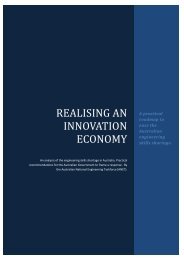scoping our future - ANET - Australian National Engineering Taskforce
scoping our future - ANET - Australian National Engineering Taskforce
scoping our future - ANET - Australian National Engineering Taskforce
You also want an ePaper? Increase the reach of your titles
YUMPU automatically turns print PDFs into web optimized ePapers that Google loves.
Scoping Our Future Addressing Australia’s <strong>Engineering</strong> Skills Shortage | 11Key Industry ShortfallsPrivate sector and public sector projects have experienced severe engineering skillsshortages over the past decade. The capacity shortfall has had differentiated impactsacross a range of sectors, with industry reporting financial and opportunity loss due toinability to attract engineering professionals.Construction• Consult Australia’s 2009 skills surveyshows that civil and structural engineeringfirms were worst hit by the skills crisis.• Industry has made the point thattendering costs are often a barrier toparticipation, with industry claiming up to$200 million in reimbursements followingthe recent axing of the NSW GovernmentCBD Metro project. 18 Scoping workis highly technical, and costs areexacerbated by key skills shortages. 19According to Blake Dawson’s reportScope for Improvement, 45 per centof respondents stated that a lackof skilled personnel was a majorcontributor to inadequate <strong>scoping</strong>.83 per cent of the respondents alsostated that the current skill crisishad made it difficult for them tofind expertise to develop adequate<strong>scoping</strong> documents.Inadequate <strong>scoping</strong> has adverseconsequences to the overall costof the projects. 61 per cent ofrespondents reported that inadequate<strong>scoping</strong> resulted in cost overrun,with more than half of those overrunscosting more than 10 per cent of thevalue of the project and a third morethan 20 per cent.For projects surveyed with a valueof more than $1 billion, around onequarter experienced a cost overrun ofmore than 20 per cent of the projectvalue (which is around $200 million ormore over the budget). Furthermore,58 per cent of respondents reporteda delay to the project, with morethan half of those delays lasting f<strong>our</strong>months or more.18 ‘Axed Metro to cost $500m’ (2010) AFR 19 March.19 Blake Dawson Waldron (2006) Scope forImprovement: A survey of pressure points in<strong>Australian</strong> construction and infrastructure projectsReport for the <strong>Australian</strong> Constructors Association.Roads• According to projections from BISShrapnel, around $2.7 billion worthof potential road construction andmaintenance work will be foregonebetween 2012-14 if lab<strong>our</strong> supply isnot increased to meet demand. 20 Thisreport indicates a chronic shortfall inengineering capacity in the road sector ofmore than 3000 engineering roles. Thisis predicted to significantly undermineother productivity improvements thatmight occur in the sector.Rail• The Australasian Railway Associationestimated that demand for railengineers in Australia outstrippedcurrent employment by around 40%. 21Rail competes with other industries forskilled staff, with a particular drain fromthe mining industry.• Competition for rail engineers is global,with a number of large rail constructionprojects in Asia and Europe draining<strong>Australian</strong> capacity. 22• Major projects affected by the lackof qualified staff include Epping toChatswood Rail Line and the RailClearways program, two projects ofwhich were cancelled in 2009 followinga skills shortages review. 2320 BIS Shrapnel (2006) Australia and New ZealandRoads Capability Analysis, 2006-2016 AustroadsResearch Report.21 Australasian Railway Association (2008) A RailRevolution: Future Capability Identification andSkills Development for the Australasian RailIndustry.22 Engineers Australia (2007) Skills Shortages in the<strong>Engineering</strong> Profession Background Paper, June.23 NSW Auditor General (2009) Auditor-General’sReport to Parliament Vol. 10, Audit Office ofNSW Government.




